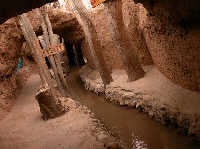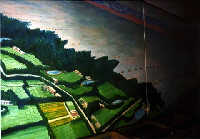| |
Karez
( 2005-09-13 )
 The word "Karez" means well. The Karez works entirely by gravity, thus eliminating the need for pumps -- it runs from high to low ground due to gravity alone. It is a very delicate irrigation system composed of four parts: a vertical well, an underground canal, an aboveground canal, and small reservoirs. The vertical wells are for the ventilation, digging, and maintenance of the Karez. The bottoms of all the vertical wells are connected so that water can pass through. The underground canal is about 2 meters high and is covered with earth to resist the heat. The surface canals, connected to the underground ones, are not more than 1 meter wide, with trees planted on both sides to prevent evaporation. The word "Karez" means well. The Karez works entirely by gravity, thus eliminating the need for pumps -- it runs from high to low ground due to gravity alone. It is a very delicate irrigation system composed of four parts: a vertical well, an underground canal, an aboveground canal, and small reservoirs. The vertical wells are for the ventilation, digging, and maintenance of the Karez. The bottoms of all the vertical wells are connected so that water can pass through. The underground canal is about 2 meters high and is covered with earth to resist the heat. The surface canals, connected to the underground ones, are not more than 1 meter wide, with trees planted on both sides to prevent evaporation.
 The Karez is built this way: First, find water source in a place where there is an underground water current; secondly, dig out vertical wells with a certain space between them; then, build underground canals connecting these wells, to allow water to flow through the underground canals. The outlets of underground canals are connected to the aboveground canals, through which the underground water can flow out and irrigate farmlands. The Karez is built this way: First, find water source in a place where there is an underground water current; secondly, dig out vertical wells with a certain space between them; then, build underground canals connecting these wells, to allow water to flow through the underground canals. The outlets of underground canals are connected to the aboveground canals, through which the underground water can flow out and irrigate farmlands.
As far back as theHan Dynasty(206BC-220AD), the Karez was recorded inRecords of the Great Historian(Shi Ji). Most of the existing Karez wells in the Turpan area were built in theQing Dynasty(1644-1911) and in later years. Nowadays, large stretches of fertile land are still irrigated by the Karez.
Generally, a Karez is 3 kilometers with the shortest being 100 meters or so, and the longest, 20 to 30 kilometers with several dozen vertical wells. Sometimes the number of vertical wells exceeds 300.
As the life source of the Turpan area, the Karez was an ingenious creation of the underground irrigation by the ancient people in Xinjiang, and was later exported to the Central Asia countries and Persia (today's Iran) via the ancientSilk Road.
|
|

